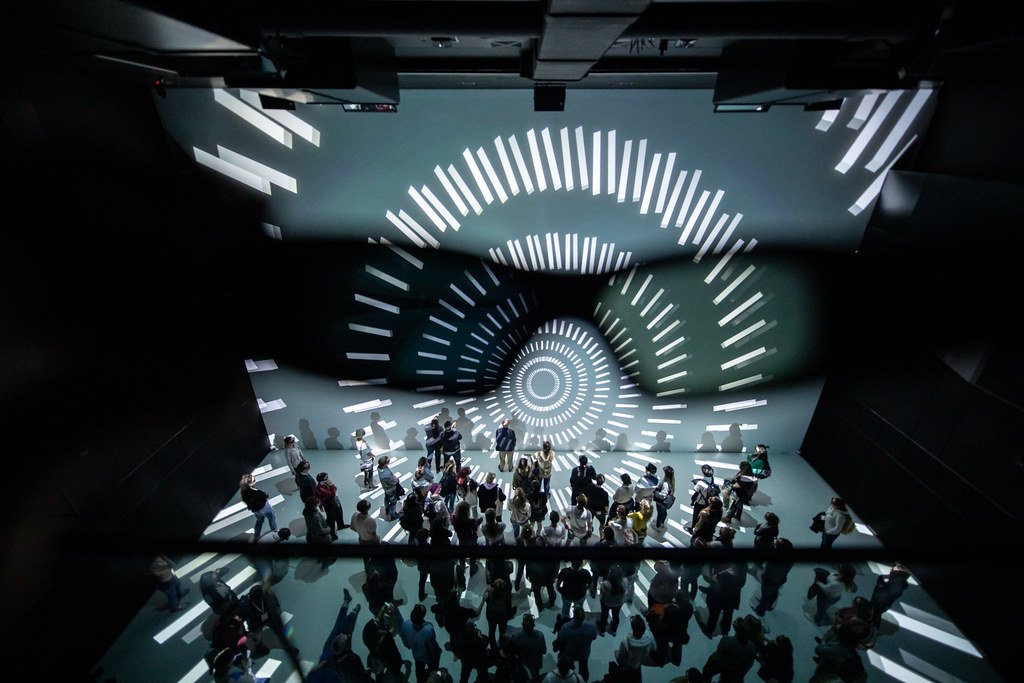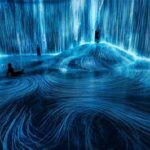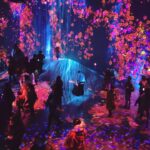In this week’s curatorial research, I explored the cutting-edge practices of Immersive Projection Exhibitions. These exhibitions have fundamentally transformed the way audiences engage with art, shifting the experience from passive viewing to full interactivity and multi-sensory immersion. By integrating large-scale projections, interactive sensors, and AI-driven systems, they create dynamic environments where visitors become an integral part of the artwork. Below are five pioneering immersive exhibitions that utilize innovative technologies to redefine curatorial strategies and audience participation.
1. teamLab Borderless
Concept:
teamLab Borderless is a digital art museum without physical boundaries, utilizing 360° projection, interactive sensors, and AI technology to create immersive visuals that change dynamically based on visitor movement.
Features:
Real-time adaptive visuals – The projections respond to visitors’ positions and movements.
No fixed boundaries – The artworks blend seamlessly, making the exhibition space ever-changing.
Audience participation – Visitors are not just observers but become part of the artwork itself.
🔗Official Website: teamLab Borderless
2. Van Gogh: The Immersive Experience
Concept:
This exhibition transforms Van Gogh’s paintings into large-scale immersive projections, allowing visitors to “step into” his world. 360° visuals and soundscapes enhance the emotional experience of his work.
Features:
Wall and floor projections – Creates an immersive environment where visitors are surrounded by Van Gogh’s artwork.
VR integration – Visitors can “walk through” Van Gogh’s paintings in a virtual experience.
Narrative-driven storytelling – Guides visitors through the artist’s life and creative process.
🔗Official Website: Van Gogh: The Immersive Experience
3. Ars Electronica Deep Space 8K
Concept:
Deep Space 8K at Ars Electronica Center combines high-resolution 8K projections, laser scanning, and interactive systems, creating hyper-realistic digital experiences that blend art, science, and technology.
Features:
8K ultra-HD projection – Ensures extreme clarity and lifelike visuals.
Multi-surface immersion – Projections extend beyond walls to include floors, enhancing spatial depth.
Data visualization – Used for exhibitions on astronomy, medical imaging, and digital storytelling.
🔗Official Website: Ars Electronica Deep Space 8K
4. L’Atelier des Lumières
Concept:
L’Atelier des Lumières is an immersive digital art center that transforms classical paintings into moving images. Large-scale projections synchronized with music create a dynamic and multisensory experience.
Features:
360° animated projections – Classical artworks move and evolve dynamically.
Music and light synchronization – Enhances the emotional depth of the experience.
Famous artist showcases – Includes exhibitions featuring Monet, Klimt, and Dalí.
🔗Official Website: L’Atelier des Lumières
5. Frameless London
Concept:
Frameless is the largest immersive digital art exhibition in the UK, featuring ultra-high-definition laser projections and interactive elements that adapt based on visitor movement.
Features:
High-definition laser projections – Creates ultra-clear, interactive digital artworks.
Motion-responsive visuals – Visitors’ movements influence the artwork’s appearance.
Multiple themed galleries – Each section showcases different artistic styles in a digital format.
🔗Official Website: Frameless London
How Do Immersive Exhibitions Break Traditional Curatorial Models?
Traditional exhibitions emphasize static presentation of physical artworks, while immersive exhibitions redefine the artistic experience through projection technology, interactive systems, and audience participation. From teamLab Borderless to Van Gogh: The Immersive Experience, these projects explore how visitors can “step into” the artwork rather than merely observing it. Key changes introduced by this model include:
✅ Breaking Spatial Boundaries – teamLab Borderless eliminates fixed borders between artworks, allowing visuals to flow and adapt to visitor movement, creating a “seamless” immersive experience.
✅ From Static Viewing to Dynamic Experience – Van Gogh: The Immersive Experience enables visitors not just to observe but to “step into” paintings, engaging in a sensory dialogue with the artwork.
✅ Integration of Technology and Art – Ars Electronica’s 8K projection system provides extreme visual precision, turning art into both a visual and data-driven scientific exploration.
These exhibitions demonstrate that curation is not just about displaying artworks but about creating experiential spaces, where audiences interact with art through their body, senses, and emotions.
How Do Immersive Exhibitions Influence Future Curators?
As curators, we must consider: If audiences are no longer passive viewers, how does the role of the curator evolve?
💡 Curators as “Experience Designers”
Traditional curation emphasizes art history, thematic narratives, and textual interpretation, whereas immersive exhibitions require curators to design a perceptual space using light, sound, and interactive installations. For instance, in L’Atelier des Lumières, curators must consider not only the meaning of the artwork itself but also how projections blend across walls, floors, and sound rhythms.
💡 Redefining Exhibition Spaces
Frameless London divides its space into multiple themed galleries, each digitally reinterpreting different artistic styles. This means the exhibition space itself becomes an editable canvas, allowing curators to “program” new thematic narratives. The challenge for curators is how to use immersive spaces to tell new curatorial stories.
💡 Interactivity and Personalized Storytelling
At teamLab Borderless, the exhibition is not just immersive but also personalized and fluid—every visitor has a unique experience.
The Future of Immersive Curation: Beyond Visual Experience
The innovation in these exhibitions lies not just in projection technology, but in how they redefine curatorial possibilities. Here are key directions for the future of curatorial practice:
🎭 Integration of Multi-Sensory Experiences
Future immersive exhibitions will go beyond visual engagement, incorporating touch, sound, and scent to create a truly embodied experience. Could curators implement haptic feedback systems that allow visitors to physically “feel” the texture of projected images?
🌍 Merging Physical and Digital Exhibitions
With technological advancements, immersive exhibitions are no longer confined to physical spaces—they can extend into VR or online interactive experiences. How can curators bridge physical and digital exhibitions, ensuring remote audiences also have immersive experiences?
📡 AI-Driven Audience Interaction
At teamLab Borderless, visuals change in real-time based on visitor behavior. This prompts the question: Can curators use AI to analyze audience engagement and dynamically adjust exhibition content? This could lead to an entirely new model of adaptive curation.
Immersive exhibitions are reshaping curatorial strategies, audience engagement, and exhibition design. As curators, our challenge is to integrate technology, interactivity, and narrative design to create the next generation of immersive art experiences.
Conclusion: The Future of Curatorial Innovation in Immersive Art
Immersive projection exhibitions are redefining the boundaries of art and audience engagement, transforming static viewing into interactive, multisensory experiences. Through advanced projection technologies, AI-driven interactivity, and dynamic storytelling, these exhibitions challenge traditional curatorial models and demand a new approach to exhibition design. As curators, we must shift from being mere presenters of artworks to experience designers, crafting environments that encourage exploration, participation, and personalized narratives. Looking ahead, the integration of multi-sensory elements, AI-driven interactions, and hybrid digital-physical exhibitions will shape the next generation of curatorial practice. The challenge now lies in how we, as curators, can harness these innovations to create exhibitions that are engaging, inclusive, and ever-evolving.







